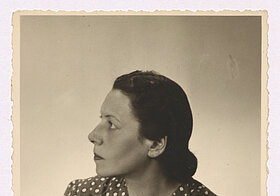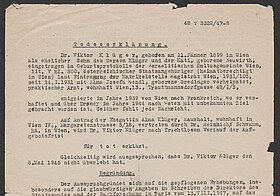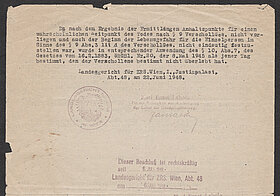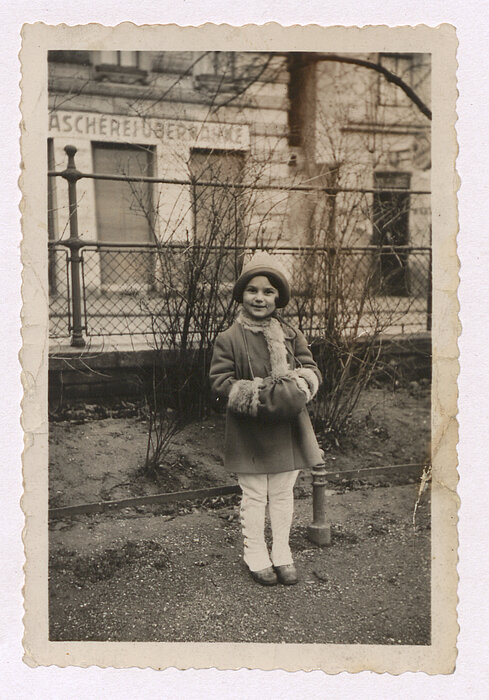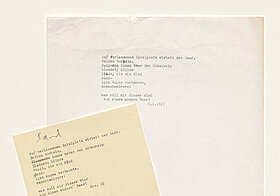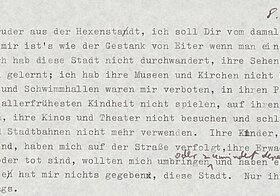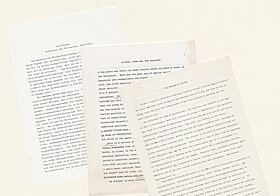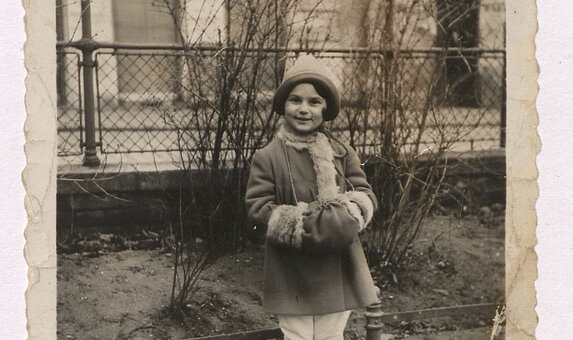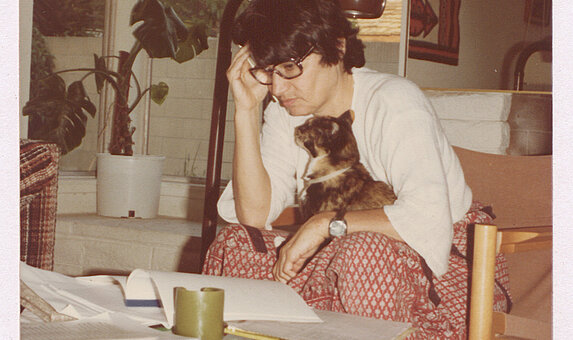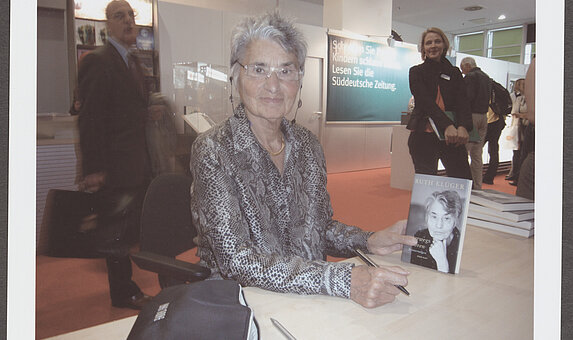Starting August 1, 2025, the State Hall will open at 9 a.m.
Annual maintenance work will take place again this summer, which is why the reading rooms at the Heldenplatz location and in all collections will be closed from Friday, July 25, to Tuesday, August 5, 2025.
Due to the shutdown of the ordering system, no media orders can be accepted from Thursday, July 24, 2025, 4 p.m. to Tuesday, August 5, 2025, 4 p.m. The regular opening hours will then apply again from Wednesday, August 6, 2025.
A Conflicted Mother-Daughter Relationship
Ruth's mother, Alma Klüger, was born in Vienna on March 4, 1903, the daughter of the Jewish sugar factory director Wilhelm Gredinger. At the age of 22, she gave birth to her first child, Jiři Mendl. After separating from her son’s father, she married the doctor Victor Klüger. In 1931 their daughter, Susanne Ruth Toni Klüger, was born. Mother and daughter survived the years in Vienna until their deportation in 1942. Life in the concentration camps in the face of extermination put an almost unimaginable strain on the bond between them. Throughout their lives, the relationship between the two women was marked by conflicts that later found their way into Ruth Klüger’s autobiographical work.
In accusatory descriptions, she processes her mother’s consistently paranoid and fundamentally mistrustful character, which had been the cause of a discomforting coexistence since early childhood. In a memorable scene, Ruth Klüger describes how, as a girl, she cut up her mother’s handbag in revenge. Since Alma Klüger had refused any contact with the German language after her emigration, she did not read her daughter’s memoirs. In order not to inflict the painful passages on her, Ruth Klüger did not write her English-language autobiography until Alma Klüger’s last days.
Her Father’s Absence
"I keep wanting to celebrate him in some way, to find or invent an appropriate way of mourning, some ceremony for him,"1 writes Ruth Klüger in the few passages of her memoirs that concern her father. When Ruth was nine years old, her father had to leave the family immediately to avoid being arrested by the Nazis. Although the Jewish doctor fled to southern France via Italy, he could not escape. He was deported to the Baltic States, where he was murdered. Ruth Klüger dedicated her poem "Mit einem Jahrzeitlicht für den Vater" to him. According to Jewish custom, she metaphorically lights a mourning candle and comes to terms with the sudden loss and everlasting longing for her departed parent. Affectionate anecdotes shape the vague image of her father: how he patiently waited for her, elegantly leaning against a fence in front of the school, how he taught her to play chess, how he sternly reprimanded her for trivialities. Above all, he was the ghost that slipped away but still haunted her life. Decades later, she talked to her mother about his disappearance and the fact that they had stayed behind, reconstructing his escape from Vienna and learning details from friends and acquaintances about his last years in exile.
1 Landscapes of Memory. A Holocaust Girlhood Remembered. Bloomsbury 2004, p. 23.
The Loss of her Brother
In her autobiography Ruth Klüger sensitively describes the short period she spent with her half-brother, Jiři Mendl, who was six years her elder. "He was my first role model, and I loved him with that peculiar craving of a small child to be more and bigger and someone else."2 As a child, she was allowed to play with him and his friends and admired his bicycle and flashlight. Even though he called his little sister clingy and annoying, she still remembered him cuddling her. However, she was only able to gather a few memories. After the divorce, Jiři’s father obtained full custody and the half-siblings were separated. When the Nazis seized power, Jiři was deported to the Theresienstadt concentration camp. Even though his mother and half-sister were imprisoned too, he would never see them again. For many years, Jiři’s fate remained uncertain. Decades later, however, Ruth Klüger learned by chance that he had been shot while being transported to Riga. Like her father, her brother also accompanied her as a ghost, reappearing and attracting her attention. In her poem "Halloween and a ghost", she contrasts the frightening ghosts of her past with the children in costume collecting candy. Whilst the children have fun, Halloween transforms into hell for Ruth Klüger.
2 Landscapes of Memory. A Holocaust Girlhood Remembered. Bloomsbury 2004, p. 20.
Ruth Klüger: "The dead are the real victims."
Source: literaturepochen.at
The Gloomy Vienna of her Childhood
When Ruth Klüger, approximately aged 5, smiled into the camera around 1936, the situation for a Jewish girl living in Vienna was already becoming threatening. Radical convictions and hatred permeated society and gradually paved the way for the rise of the Nazi Party and Austria’s "Anschluss" to Hitler's Germany. However, her winter coat, cap, and muff still protected her from the icy wind that whistled through the narrow streets. She romped with her peers through the Esterházy Park in Vienna’s sixth district. The park, to which she gave the name "Hasipark", became the scene of imaginative play. Decades later, Ruth Klüger evoked the extinct ghostly "Hasipark" in a poem: "Auf verlassenem Spielplatz wirbelt der Sand […] / Stadt, die ein Kind […] verbannte."3 As her playmates gradually disappeared without a trace, loneliness overcame the young mind. Ruth Klüger found encouragement in books she devoured at random, in poems she learned by heart, in amusing rhymes she composed in her head. After long wanderings through the hostile city that demanded her "extermination" with aggressive propaganda, she hid the Star of David and escaped into the distraction of the cinema. In September 1942, together with her mother and grandmother, she was deported from Vienna to the Theresienstadt concentration camp.
3 Literal Translation: "On abandoned playground swirls the sand […] / City that banished a child […]."
Ruth Klüger on Vienna’s antisemitism
Source: literaturepochen.at
Theresienstadt or “The Talent of Friendship”

For Ruth Klüger, the Theresienstadt concentration camp became a place of illness and epidemics, the place where she lost her weakened grandmother. While with her the affectionate center of the family and the traditionally lived Jewish values were laid to rest, the lonely girl gradually developed her own social consciousness. In the strictly regulated children’s community, the 11-year-old blossomed. She developed a peculiar quality that she would later call, not without pride, a "talent for friendship." Ruth Klüger also found her best friend in the concentration camp, Hanna Ungar from Vienna. After her liberation, Ungar emigrated to Australia and remained in touch with Ruth Klüger throughout her life. In the camp, they attended provisional classes together in hidden attics with imprisoned scholars who taught Jewish history, culture and language. However, the hopelessness of the situation was still too overwhelming for Ruth Klüger to be able to enjoy the longed-for feeling of community and to satisfy her thirst for knowledge. Impatiently, she kept an eye out for her untraceable brother, heard unbelievable stories about deadly gas showers and said goodbye to her newfound friends as they boarded the freight cars heading east.

The Irrepressible Will to Survive in Auschwitz-Birkenau
Daylight must have been blinding as the child was pushed out of the dark and stinking freight car and fell onto the dreaded ramp of the Auschwitz-Birkenau death camp. "[…] it smelled like nothing on earth."4 A few hours later, the life-affirming 12-year-old would impulsively defy her desperate mother’s suggestion that they throw themselves onto the electric barbed wire. Just as the concentration camp number A-3537 was tattooed in fine dots on the young girl’s skin, the traumatic experiences of the following two months were deeply inscribed in the memory of the survivor: hours of roll calls in the sweltering summer heat, unspeakable thirst during sleepless nights, trucks full of naked, malnourished corpses and the fear of death in the face of impending selections. Thanks to a lot of luck, the decisive good deed of a completely unknown fellow prisoner, and a lie, Ruth Klüger succeeded in leaving the death camp alive. Together with her mother, she was transferred to the Christianstadt, Gross-Rosen labor camp. Right up to the end of her life, she appeared as a contemporary witness in both the U.S and Europe. She talked about her experiences at Auschwitz-Birkenau concentration camp and resolutely took a stand for remembering the Holocaust.
4 Landscapes of Memory. A Holocaust Girlhood Remembered. Bloomsbury 2004, p. 108.
A Poem of Revenge from Christianstadt
On a cold afternoon in the winter of 1944/45, 13-year-old Ruth Klüger stood in front of her fellow prisoners in the Christianstadt labor camp and recited her poem of revenge. Her personified chimney in Auschwitz thirsts for the perpetrators, "Und die mich gebaut als Grab, schling ich selbst zuletzt hinab […]."5 Decades later, Věra Hájková, a fellow sufferer of this severe cold and hunger, still remembered her friend’s performance in a letter. Together with the poem "Auschwitz", which expresses hope for freedom, "Der Kamin" is one of Klüger’s earliest poetic works. The verses, scribbled to save space on a double page only after the war, impressively demonstrate Ruth Klüger’s confrontation with her experiences, as well as her courage to find suitable words for the atrocities she witnessed. After the hectic dissolution of the labor camp in the spring of 1945, Alma Klüger, her stepdaughter Susi, whom she adopted in Auschwitz, and Ruth escaped the death march. With forged identity papers and a euphoric spirit of freedom, the small family made its way across Germany to Straubing in Bavaria. They bit into long-awaited fresh apples and joked with other refugees along the way. The liberty they had regained still outshone all the suffering they had experienced, but the memories would soon return.
5 Literal Translation: "And those who built me as a grave, I myself will swallow in the end […]."
Work of Remembrance or Breaking out of the "Cage of the Past"
What else was a child to do but repress its feelings when faced with existential crisis, when it experienced traumatic losses? In a poem, written after decades of distance, the mature writer discovers her young and angry self in a "cage of the past." She reflects on the anxiety-ridden burden of remembering. As a Holocaust survivor, she urges her fellow human beings to call the places by their names and repeat them out of respect for those who were murdered: "Theresienstadt, Auschwitz, Gross-Rosen / […] Sprich sie nach."6 Just as the earliest poems find explicit words for the crematoria at Auschwitz, these verses are also characterized by clear language and provocative simplicity. The poem joined Ruth Klüger’s relentless work of remembrance, culminating in the indictment of a transfigured "concentration camp kitsch." In the Bonn Poetics Lectures in the winter semester of 1994/95, she warned against the sensational and drastic presentations of shoes, teeth or hair in the Auschwitz memorial. In contrast to emotionally overloaded moments of shock, Klüger found a humane way out: authentic narration on the one hand, attentive listening on the other. In her eyes, coming to terms with the Holocaust requires the respectful cooperation between survivors, perpetrators, and those born afterwards. This is the only way to overcome the unprecedented catastrophe of the 20th century.
6 Literal Translation: "Theresienstadt, Auschwitz, Gross-Rosen / […] Repeat them."
Ruth Klüger on the effects of memorials
Source: Literaturepochen.at


